Thinking about stepping into the world of online dating startups? You're not alone.
The online dating industry is booming, with millions of users swiping, matching, and chatting every day.
It’s a space that continues to grow, driven by the increasing acceptance of digital relationships and the ease of finding potential partners through technology.
Starting an online dating startup is more than just a business opportunity, it’s a chance to connect people in meaningful ways.
Whether it’s casual dating, long-term relationships, or niche matchmaking, the possibilities are vast.
But where do you begin? How do you take an idea from concept to a fully-fledged business?
This blog will guide you through every step, from preparation to product development, launching your platform, and beyond.
By the end, you'll not only know how to start an online dating startup but also how to position it for long-term success in a competitive market.
What’s an Online Dating Business?
An online dating business is a platform where people can connect, interact, and build relationships digitally.
These businesses operate through websites or mobile apps, providing a convenient and accessible way for users to find companionship, romance, or even long-term partnerships.
At its core, an online dating business typically features:
-
- Profiles: Where users showcase their personality, preferences, and photos.
- Matching Algorithms: Smart technology that pairs users based on shared interests, compatibility, or proximity.
- Communication Tools: Messaging systems, video calls, or other features to facilitate interaction.
Online dating startups can cater to different niches, such as LGBTQ+ communities, professionals, or those seeking specific interests, adding a unique value to the users’ experience.
But running an online dating business isn’t just about creating an app. It’s about building trust, ensuring user safety, and offering innovative features that keep people engaged.
With the global dating app market expected to surpass $12 billion by 2030, it’s clear that this is an industry brimming with potential.
Whether you’re planning to cater to a broad audience or focus on a specific niche, the opportunities are as vast as the connections your app will create.
Why Start an Online Dating Business?
Starting an online dating business is more than just capitalizing on a trend-it’s about leveraging a growing industry to create a sustainable and impactful venture. Let’s dive into the key reasons why this sector is worth exploring:
1. A Thriving Industry with Growing Demand
The online dating market is experiencing unprecedented growth. Millions of people worldwide are using dating platforms, with the number increasing yearly. The convenience of finding potential partners online has shifted societal norms, making digital matchmaking an integral part of modern relationships.
-
- Statistics Speak for Themselves: Platforms like Tinder, Bumble, and Hinge boast millions of active users globally. With the industry set to reach $12 billion by 2030, the market demand is evident.
- Appealing to All Demographics: From young adults to middle-aged professionals, online dating appeals to diverse age groups and lifestyles. This versatility allows you to cater to a broad audience or focus on niche markets.
2. Multiple Revenue Streams
The financial prospects in the dating business are immense, thanks to diverse monetization models. You can create recurring revenue through:
-
- Subscription Plans: Offer premium memberships with exclusive features like unlimited swipes, super likes, or advanced filters.
- In-App Purchases: Allow users to buy virtual gifts, boosts, or credits.
- Advertisements: Collaborate with brands for targeted ads within the app.
- Freemium Models: Attract users with free basic features while charging for advanced functionalities.
This flexibility means you can tailor your revenue model to your target audience and business goals.
3. Scalability and Global Reach
Once your platform gains traction, scaling it becomes straightforward. Online dating businesses can easily expand across:
-
- Geographies: Target new regions or countries to grow your user base.
- Niches: Cater to specific communities like LGBTQ+, professionals, gamers, or pet lovers.
- Features: Introduce video calls, AI matchmaking, or gamified dating experiences to keep users engaged.
With technology and digital tools, your business can achieve exponential growth without significant additional investment.
4. A Space for Innovation
The online dating industry thrives on innovation. If you can think of a feature or have a dating app idea that hasn’t been done before, there’s a good chance users will flock to it. Here are some ideas:
-
- AI-Powered Matchmaking: Leverage machine learning to offer smarter matches based on behavior patterns.
- Gamified Dating: Make the experience interactive and fun through games or quizzes.
- Video-First Platforms: Emphasize real-time interactions through video chats or live virtual events.
By bringing fresh ideas to the table, you can carve out a unique identity in the market.
5. Making a Positive Impact
An online dating platform isn’t just a business-it’s a facilitator of human connections. Whether helping someone find their soulmate or enabling people to meet others with similar interests, your platform will play a vital role in shaping lives.
This emotional and social impact adds a sense of fulfilment to your entrepreneurial journey.
6. Relatively Low Entry Barriers
Starting an online dating business doesn’t require massive upfront costs compared to other industries.
With a solid app development partner, you can quickly bring your idea to life. Plus, cloud computing and SaaS solutions make it easier than ever to build and manage a scalable platform.
Why Now Is the Right Time?
The pandemic accelerated the adoption of digital dating, making it the preferred method for meeting people. This shift in behavior continues to drive market growth, making now an ideal time to establish your presence in the online dating world.
App Development vs. Starting an Online Dating Business
When planning an online dating startup, you’ll face a fundamental choice:
Should you focus solely on creating a dating app or build an entire business around it?
While these concepts are interconnected, they are not the same. Let’s break it down:
► Dating App Development
This involves designing and building the technical platform (app or website) that users interact with.
It’s primarily about technology, user experience, and features.
Core Elements:
-
- UI/UX design to make the app intuitive.
- Backend development for seamless functionality.
- Security protocols for data protection.
Focus: A well-designed app ensures your users stay engaged. The technical excellence of the app is critical for user satisfaction.
► Starting an Online Dating Business
Building a business goes beyond app development. It involves strategy, branding, marketing, user acquisition, and creating a sustainable model for growth and revenue.
Core Elements:
-
- A business plan to outline your niche, goals, and revenue streams.
- Marketing and branding to attract and retain users.
- Operational planning for scaling and market expansion.
Focus: Starting a business requires balancing app development with strategies for growth, user trust, and market positioning.
|
Aspect |
App Development |
Starting a Business |
|
Scope |
Focuses on building the app or website functionality. |
Includes app development, branding, and operations. |
|
Key Components |
Design, development, features, and testing. |
Strategy, marketing, revenue generation, and growth. |
|
Goal |
Deliver a user-friendly and reliable app. |
Build a long-term, scalable business model. |
|
Investment |
One-time or periodic cost for development and updates. |
Ongoing investment in development, marketing, and scaling. |
|
Revenue Focus |
Monetization features in the app. |
Comprehensive revenue strategies beyond the app. |
|
Risk Management |
Limited to technical risks like bugs or outages. |
Involves market, operational, and technical risks. |
To succeed, you need to think beyond the app.
A great dating platform is the backbone of your business, but strategic planning and effective execution are what transform it into a thriving venture.
If you can combine technical excellence with a strong business model, your online dating startup will have the best chance to stand out in this competitive market.
Step 1: Preparation - Checklist to Start an Online Dating Business (Detailed Guide)
Launching a successful online dating business begins with careful and strategic preparation.
Below is a step-by-step guide, elaborating on the essential tasks you need to accomplish before developing your platform.
1. Define Your Niche and Target Audience
The key to standing out in the competitive dating market is to target a specific group of users. By identifying a niche, you can cater to unique needs and preferences, making your platform more appealing.
For example, if you’re looking to serve the LGBTQ+ community, you can create an LGBTQ app to offer them safe space & a top-notch experience.
Why Choose a Niche?
-
- Broad dating platforms face intense competition.
- Niches allow you to establish expertise and a loyal user base.
Popular Niche Examples:
-
- LGBTQ+ Dating: Apps like HER focus on inclusivity.
- Professional Networking Meets Dating: The League targets high-achieving professionals.
- Hobby-Based Dating: Tastebuds connects music enthusiasts.
How to Define Your Niche:
-
- Research underserved audiences or specific demographics.
- Use surveys or focus groups to validate demand.
2. Conduct Thorough Market Research
Understanding the market is critical for identifying gaps, opportunities, and user behaviour.
Steps to Conduct Research:
A. Analyze Competitors: Examine apps like Tinder, Bumble, and niche competitors. Look for:
-
- What features work well for them.
- Complaints or gaps in user experience.
B. Study Industry Trends:
-
- Use reports from platforms like Statista and IBISWorld.
- Track emerging technologies such as AI-powered matchmaking or AR/VR dating experiences.
C. Understand User Expectations:
-
- What features do users value? (e.g., swiping, video chats, etc.)
- What are common complaints about existing platforms?
3. Create a Robust Business Plan
Your business plan serves as a roadmap, helping you make informed decisions and attract investors.
What to Include:
-
- Executive Summary: A brief overview of your business idea and goals.
- Target Audience: Detailed demographic and psychographic analysis.
- Revenue Streams: Specify monetization models (e.g., subscriptions, ads, or in-app purchases).
- Marketing Plan: Strategies to acquire users (social media, SEO, partnerships).
- Financial Projections:
-
-
-
- Development costs.
- Marketing expenses.
- Expected ROI over the next 3-5 years.
-
-
-
4. Choose the Right Technology Partner
A skilled app development company can make or break your online dating business. Look for developers who have experience in building scalable, secure, and feature-rich apps.
Key Features Your Development Partner Should Offer:
-
- Expertise in frameworks like Node.js, React Native, or Flutter.
- Familiarity with AI and machine learning for matchmaking algorithms.
- Knowledge of data privacy regulations (GDPR, CCPA).
- Experience in integrating third-party tools for payment processing or video calls.
How to Select a Partner:
-
- Check portfolios and past work.
- Request detailed project timelines and budgets.
- Read reviews or ask for references.
5. Secure Funding
Building a dating business requires significant financial investment. From development to marketing, you’ll need resources to scale effectively.
Options to Consider:
-
- Bootstrapping: Use personal savings to start small.
- Angel Investors: Pitch your idea to investors who specialize in startups.
- Venture Capital: Seek funding from VCs interested in tech and app-based businesses.
- Crowdfunding: Platforms like Kickstarter allow you to raise money while gaining early users.
Budget Breakdown:
- App Development: $30,000–$200,000 depending on complexity.
- Marketing: 20–30% of your budget.
- Legal and Compliance: $5,000–$15,000 for policies and agreements.
- Maintenance and Updates: Recurring cost post-launch.
6. Understand Legal and Compliance Requirements
Legal considerations are crucial to protect your business and users. Non-compliance can lead to lawsuits or fines.
Key Areas to Address:
- Data Privacy Laws: Ensure compliance with laws like GDPR (EU) and CCPA (California) to protect user information.
- Terms and Conditions: Clearly outline user responsibilities and platform rules.
- Age Verification: Implement robust systems to restrict underage users.
- Anti-Fraud Measures: Protect users from scams or fake profiles.
7. Build a Brand Identity
Your brand is more than a logo-it’s the personality of your business. A strong identity can attract users and foster trust.
How to Build Your Brand:
- Choose a memorable name and design a professional logo.
- Define your brand’s tone and voice (e.g., friendly, professional, or witty).
- Use colors and design elements that resonate with your audience.
Tip: Consistency is key. Your website, app, and marketing materials should all reflect your brand identity.
8. Develop a Marketing Strategy
Attracting users is critical, especially in the early stages. A well-planned marketing strategy can help you gain traction quickly.
Effective Strategies:
-
- Social Media Marketing: Use platforms like Instagram and TikTok for targeted ads and influencer collaborations.
- SEO: Optimize your app’s website with keywords like online dating app or best dating platform.
- Referral Programs: Encourage existing users to invite friends by offering perks or discounts.
- Content Marketing: Publish blogs, videos, or user success stories to build credibility.
9. Plan Monetization Early
Your revenue model should be integral to your planning phase.
Monetization Models:
-
- Freemium: Offer free basic services and charge for premium features.
- Subscription Plans: Create tiers with added benefits for paying users.
- In-App Purchases: Allow users to buy virtual gifts, boosts, or credits.
- Ads: Partner with relevant brands for in-app advertisements.
10. Establish Customer Support
Exceptional customer service builds user trust and loyalty.
Features to Include:
-
- FAQs: Address common questions and issues.
- Chatbots: Provide instant responses to basic queries.
- Live Support: Offer human interaction for complex problems.
By completing this preparation checklist, you’ll be ready to tackle the next phase: developing your online dating platform. This groundwork ensures that your business is well-positioned for success in a competitive market.
Step 2: Product Development - Steps to Develop an Online Dating Platform
Developing an online dating platform requires combining technical expertise, user-focused design, and innovative features to stand out in a competitive market. Here’s a detailed, step-by-step guide to help you bring your idea to life:
1. Define the Core Features of Your Platform
Your app’s features determine its functionality and user appeal. Begin by identifying the must-haves for your platform, focusing on user experience, safety, and engagement.
Essential Features:
1. User Registration and Profile Setup:
-
- Multiple sign-up options (email, social media).
- Profile customization (photos, bios, interests).
2. Search and Matchmaking:
-
- Search filters (age, location, interests, etc.).
- AI-powered matchmaking algorithms for compatibility.
3. Communication Tools:
-
- In-app messaging.
- Video or voice calls for better interaction.
4. Privacy and Security:
-
- Profile verification (e.g., phone number, photo ID).
- Two-factor authentication.
- Reporting and blocking features for user safety.
5. Gamified Features:
-
- Swiping or liking profiles to make interactions engaging.
- Virtual gifts and badges for rewarding user actions.
Advanced Features to Consider:
-
- AI Recommendations: Machine learning algorithms to suggest matches based on behavior.
- Geolocation: Find matches nearby with location-based suggestions.
- Virtual Dating: Enable live video chats or AR-based interactions for immersive experiences.
2. Choose the Right Tech Stack
Selecting the appropriate technology stack ensures that your platform is scalable, fast, and secure.
Backend Development:
-
- Frameworks: Node.js, Django, Ruby on Rails.
- Databases: PostgreSQL, MongoDB, or Firebase for real-time data.
- Cloud Platforms: AWS or Google Cloud for hosting.
Frontend Development:
-
- Frameworks: React.js, Angular, or Vue.js for intuitive interfaces.
- Mobile App Development: Use React Native, Flutter, or Swift (iOS) and Kotlin (Android).
Security Measures:
-
- End-to-end encryption for user messages.
- Secure payment gateways for premium subscriptions.
- Regular vulnerability assessments and penetration testing.
3. Create an Intuitive and Engaging User Interface
Your app’s design plays a significant role in user retention. Aim for a layout that is visually appealing, simple to navigate, and responsive across devices.
Best Practices for UI/UX:
-
- Use minimalistic design with clear navigation.
- Ensure quick load times for seamless browsing.
- Include onboarding tutorials to guide new users.
- Test designs with focus groups for usability feedback.
4. Develop the MVP (Minimum Viable Product)
An MVP allows you to launch quickly with essential features, gather user feedback, and make improvements based on real-world usage.
Steps to Develop an MVP:
-
- Focus on core functionalities (registration, matchmaking, messaging).
- Exclude advanced features that can be added later.
- Test the MVP rigorously to fix bugs and ensure stability.
Benefits of an MVP:
-
- Faster time-to-market.
- Lower initial development costs.
- Early feedback to shape the final product.
5. Integrate Monetization Features
Monetization strategies should be woven into the development phase to ensure a seamless user experience.
Monetization Methods:
-
- Subscription Plans: Offer premium tiers with exclusive perks (e.g., unlimited swipes, advanced filters).
- In-App Purchases: Allow users to buy boosts, virtual gifts, or credits.
- Advertisements: Display relevant ads without disrupting the user experience.
- Freemium Model: Provide basic features for free while charging for premium services.
6. Focus on Security and Compliance
User trust is crucial for any dating platform. Prioritize data security and adhere to legal standards.
Key Security Measures:
-
- Encrypt user data, especially personal details and payment information.
- Implement identity verification to reduce fake profiles and scams.
- Use secure cloud storage and perform regular security updates.
Compliance Standards:
-
- Follow GDPR (EU), CCPA (California), and other regional data protection laws.
- Clearly communicate terms of use and privacy policies.
- Include age verification features to restrict underage users.
7. Conduct Rigorous Testing
Testing ensures your platform performs well across different devices, operating systems, and scenarios.
Types of Testing:
-
- Functionality Testing: Ensure all features work as intended.
- Performance Testing: Check app speed, scalability, and responsiveness under high traffic.
- Security Testing: Identify vulnerabilities to prevent breaches.
- Usability Testing: Test with real users for feedback on navigation and user experience.
Common Tools for Testing:
-
- Selenium (automated testing).
- JMeter (performance testing).
- OWASP ZAP (security testing).
8. Plan for Continuous Updates and Maintenance
Launching your platform is just the beginning. Regular updates and maintenance are essential to keep users engaged and satisfied.
Post-Launch Activities:
-
- Roll out new features based on user feedback.
- Fix bugs and optimize app performance.
- Update security measures to protect against evolving threats.
9. Collaborate with Experts for Development
If you lack in-house expertise, partnering with a professional development company like JPLoft can streamline the process. They bring:
-
- Experience in creating feature-rich dating platforms.
- Expertise in scalable and secure app development.
- Support for post-launch updates and maintenance.
By following these steps, you can create a dating platform that is not only functional but also stands out in the crowded market. With your product ready, it’s time to move to the next stage:
Step 3: Launching the Business
Once your online dating platform is developed, it’s time to launch your business.
A successful launch requires careful planning, strategic execution, and a focus on creating buzz to attract your first wave of users.
Let’s explore the detailed steps for launching your online dating startup:
1. Prepare for the Launch
Your pre-launch phase is critical for setting the stage. It involves building awareness, ensuring technical readiness, and gathering initial users.
Build a Landing Page:
-
- Create a visually appealing website to introduce your platform.
- Include a countdown timer for the launch date, benefits of your app, and a call-to-action (e.g., "Sign Up Now" or "Join the Waitlist").
Run Beta Testing:
-
- Invite a select group of users to test the platform before the official launch.
- Use their feedback to fix bugs, improve features, and validate usability.
Build Social Media Presence:
-
- Create profiles on platforms like Instagram, TikTok, Facebook, and LinkedIn.
- Share sneak peeks, user testimonials, or features to build excitement.
Partnerships and Collaborations:
-
- Partner with influencers, bloggers, or communities that align with your niche.
- Leverage their audiences to gain early adopters.
2. Create a Launch Marketing Plan
Your launch marketing strategy should create a buzz, drive user acquisition, and build momentum.
Strategies to Use:
-
- Paid Ads: Run targeted ad campaigns on Google, Instagram, and Facebook to reach your ideal audience.
- Referral Programs: Offer incentives for users to invite friends, such as free premium features or discounts.
- Content Marketing: Publish blogs, videos, and case studies about online dating trends and your platform's unique features.
- PR Campaigns: Reach out to media outlets and tech blogs to announce your launch and highlight your niche.
3. Execute a Soft Launch
A soft launch is a controlled rollout where you release your app to a smaller audience or specific region before the global launch.
Benefits of a Soft Launch:
-
- Identify and fix potential issues.
- Test marketing strategies and user acquisition tactics.
- Collect user feedback to improve the platform.
Key Steps:
-
- Release the app in one or two regions.
- Focus on acquiring a small but engaged user base.
- Monitor analytics for performance and usage patterns.
4. Plan Your Official Launch Event
The official launch is your opportunity to create a big splash in the market.
Event Ideas:
- Host a virtual launch party or webinar.
- Offer limited-time perks like free premium subscriptions or discounts for early users.
- Create shareable content (e.g., videos, memes, or GIFs) to encourage users to spread the word.
Monitor Launch Metrics:
-
- Track downloads, user sign-ups, and engagement during the launch week.
- Use analytics tools like Google Analytics, Mixpanel, or Firebase to measure success.
5. Address Post-Launch Challenges
Launching is just the beginning. Post-launch, you’ll need to focus on user retention, performance optimization, and scaling.
Onboarding Users:
-
- Guide users through the app with tutorials or walkthroughs.
- Send personalized emails or notifications to welcome new users.
User Engagement Strategies:
-
- Add gamification elements like daily streaks or badges to keep users coming back.
- Regularly introduce new features or updates based on user feedback.
Resolve Issues Promptly:
-
- Monitor app reviews and social media comments to address complaints.
- Provide quick customer support to resolve user queries.
6. Scale Your Operations
Once your platform gains traction, scaling becomes the next goal.
Expand Your Reach:
-
- Target additional regions or demographics.
- Translate your app and marketing materials for new markets.
Introduce Advanced Features:
-
- Add functionalities like AI matchmaking, advanced search filters, or video dating to keep users engaged.
Optimize Marketing Campaigns:
-
- Use data from your launch to refine marketing efforts.
- Invest in long-term strategies like SEO, influencer marketing, and partnerships.
7. Build and Maintain Trust
Trust is the foundation of any online dating platform. Ensure that users feel safe and valued.
Enhance Safety Features:
-
- Implement robust reporting and moderation systems.
- Use machine learning to detect fake profiles or fraudulent activities.
Foster Community Engagement:
-
- Create forums, events, or blogs that resonate with your audience.
- Encourage users to share their success stories on your platform.
Launching an online dating business is an ongoing process. While the initial rollout sets the stage, your focus should shift toward sustaining growth, refining the user experience, and staying ahead of industry trends.
Challenges You Might Face & Their Solutions
Launching and managing an online dating business is a rewarding journey, but it comes with hurdles that require strategic solutions.
Here’s an in-depth look at potential dating app challenges and actionable solutions to overcome them.
► Acquiring and Retaining Users
Attracting users to a new dating platform is tough, especially when competing with well-established players. Retention becomes equally challenging as users demand engaging features and a seamless experience.
User Acquisition Strategies:
-
- Leverage paid advertising on platforms like Facebook, Instagram, and TikTok to target specific demographics and niches.
- Create a referral program where existing users get incentives for inviting friends.
- Partner with influencers or bloggers in your target niche to reach a wider audience.
- Host pre-launch events or offer early access to create excitement and gather initial users.
Retention Strategies:
-
- Add gamification elements, such as daily rewards, streaks, or leaderboards, to make the experience enjoyable.
- Send personalized push notifications about potential matches or updates to keep users engaged.
- Continuously update the app with new features based on user feedback to maintain their interest.
► Building User Trust and Ensuring Safety
Trust is a cornerstone of any dating platform. Users need assurance that their data is secure, and their interactions are safe from scams or harassment.
Safety Features:
-
- Implement profile verification processes like photo ID checks or linking to social media accounts to ensure authenticity.
- Include a “Report” and “Block” feature for users to flag inappropriate behavior.
- Use AI algorithms to detect fake profiles or suspicious activities and remove them proactively.
- Provide users with safety tips directly on the platform to educate them about secure online interactions.
Data Security:
-
- Encrypt all user data, especially sensitive information like messages and payment details.
- Regularly conduct security audits and vulnerability tests to safeguard against breaches.
- Comply with regional data protection regulations like GDPR and CCPA.
► Differentiating Your Platform from Competitors
In a crowded market, standing out is essential. Without a clear unique value proposition, your platform risks blending into the sea of dating apps.
Defining a Unique Niche:
-
- Focus on underserved audiences or specific niches, such as single parents, gamers, or pet lovers.
- Highlight your app’s unique features, such as AI-powered compatibility scoring or virtual dating events.
Innovative Features:
-
- Offer AR-based date ideas or real-time virtual date experiences.
- Introduce compatibility quizzes or icebreaker games to make interactions more engaging.
- Include community features like forums or interest-based groups for users to connect beyond matchmaking.
► Monetizing Without Alienating Users
Users can be put off by aggressive monetization strategies, such as excessive ads or paywalls that block basic functionality.
Balanced Monetization Models:
-
- Offer a freemium model with essential features available for free and advanced features behind a paywall.
- Limit the frequency of ads and ensure they are relevant to your audience.
- Introduce affordable and flexible subscription plans with clear value propositions.
- Test various models, such as in-app purchases or premium memberships, to see what resonates best with your users.
► Managing Technical Issues
Technical glitches, slow load times, or app crashes can lead to frustration and user attrition.
Proactive Measures:
-
- Select a scalable tech stack during development to handle sudden spikes in user activity.
- Conduct regular performance tests to identify and fix bottlenecks.
- Use reliable cloud services like AWS or Google Cloud to maintain uptime and speed.
Post-Launch Technical Support:
-
- Hire a dedicated team for maintenance and updates.
- Implement robust logging and monitoring systems to detect and resolve issues in real-time.
► Maintaining Engagement Over Time
Users may lose interest if the app fails to keep them engaged, leading to churn.
Engagement Strategies:
-
- Send personalized updates about potential matches, new features, or events.
- Host themed virtual events, like speed dating nights or interest-based meetups, to keep users active.
- Use machine learning to improve matchmaking accuracy, ensuring users find relevant and compatible profiles.
► Adapting to Regulatory and Compliance Requirements
Data protection regulations and evolving laws around online platforms can be challenging to keep up with.
Compliance Steps:
-
- Stay updated on regional and international regulations like GDPR (Europe) and CCPA (California).
- Work with legal experts to draft comprehensive terms of service and privacy policies.
- Clearly communicate data collection practices to users and provide them with control over their information.
► Scaling While Maintaining Quality
As your user base grows, it can be challenging to maintain the quality of service without compromising on performance or user satisfaction.
Strategies for Scaling:
-
- Automate processes like user verification and matchmaking to handle larger volumes efficiently.
- Invest in advanced cloud infrastructure to support increasing traffic.
- Expand your team to include specialized roles for operations, marketing, and customer support.
► Overcoming Negative Publicity
Negative reviews or incidents can damage your platform’s reputation and deter potential users.
Crisis Management:
-
- Respond promptly to user complaints on app stores or social media with professionalism and empathy.
- Actively monitor your online presence to address concerns before they escalate.
- Highlight success stories and positive testimonials to counterbalance negative feedback.
► Tackling Cultural Sensitivities Across Markets
Expanding globally can bring challenges related to varying cultural norms and expectations.
Cultural Customization:
-
- Localize your app by offering region-specific languages, preferences, and cultural elements.
- Work with local consultants to understand and respect cultural differences.
- Adapt features, such as matchmaking algorithms, to reflect regional dating norms and practices.
By anticipating these challenges and implementing proactive solutions, you can create a resilient online dating platform that thrives in a competitive market.
Popular Online Dating Businesses & Their Success Stories
The online dating industry is packed with success stories of platforms that revolutionized the way people connect.
These examples showcase how unique ideas, user-centric features, and effective marketing strategies can lead to phenomenal growth.
1. Tinder: The Swipe Revolution
Launched in 2012, Tinder transformed the online dating space with its innovative "swipe" feature, making matchmaking quick and engaging. This is why many wants to create an app like Tinder.
Success Factors:
-
- Gamification: Tinder’s swipe mechanism gamified the dating experience, making it simple and addictive.
- Freemium Model: Basic features were free, while premium options like Tinder Plus and Tinder Gold offered exclusive perks.
- Social Media Integration: Connecting through Facebook simplified registration and enhanced profile authenticity.
Key Milestone: Tinder boasts over 75 million monthly active users and generates billions in revenue annually, making it one of the most successful dating platforms globally.
2. Bumble: Empowering Women in Dating
Founded by Whitney Wolfe Herd in 2014, Bumble stood out with its women-first approach, where only women could initiate conversations. For those who wants to create an app like Bumble, It’s time to focus on unique approach.
Success Factors:
-
- Empowered Approach: By giving women control, Bumble addressed safety concerns and created a unique value proposition.
- Expanding Beyond Dating: Bumble added Bumble BFF (for friendships) and Bumble Bizz (for networking), increasing its appeal.
- Strong Branding: Bumble’s bright yellow branding and focus on empowerment resonated with millennials and Gen Z.
Key Milestone: Bumble became a publicly traded company in 2021, achieving a valuation of over $13 billion.
3. OkCupid: The Compatibility Pioneer
Launched in 2004, OkCupid was among the first platforms to use detailed questionnaires and compatibility scoring to match users.
Success Factors:
-
- Data-Driven Matchmaking: OkCupid’s compatibility percentages helped users find meaningful connections.
- Inclusivity: The platform allowed users to define their sexual orientation and preferences, appealing to diverse demographics.
- User Engagement: Thought-provoking questions and quirky prompts kept users engaged.
Key Milestone: Despite fierce competition, OkCupid remains popular, with over 50 million registered users worldwide.
4. Hinge: Focused on Long-Term Connections
Hinge markets itself as the app "designed to be deleted," emphasizing long-term relationships over casual dating. It attracts users as well as investors to create an app like Hinge to replicate its success.
Success Factors:
-
- Profile Depth: Hinge allows users to answer prompts and add personal touches to their profiles, fostering genuine connections.
- User Feedback Loop: Features like "We Met" collect feedback to improve matchmaking algorithms.
- Minimal Swipe Culture: Hinge replaced endless swiping with thoughtful interactions, making it ideal for serious daters.
Key Milestone: Hinge has grown exponentially and is now a preferred platform for users seeking meaningful relationships.
5. Grindr: The LGBTQ+ Trailblazer
Grindr, launched in 2009, was the first dating app to cater specifically to the LGBTQ+ community, leveraging geolocation technology.
Success Factors:
-
- Niche Focus: By targeting LGBTQ+ users, Grindr filled a gap in the market and became a safe space for the community.
- Real-Time Proximity Matching: Its location-based feature allowed users to connect instantly with nearby individuals.
- Community Engagement: Grindr also provided resources and information on LGBTQ+ issues, fostering a sense of belonging.
Key Milestone: Grindr remains one of the top dating apps for the LGBTQ+ community, with over 10 million active users monthly.
6. EliteSingles: Catering to Professionals
EliteSingles carved its niche by focusing on educated professionals seeking serious relationships.
Success Factors:
-
- Targeted Demographic: The platform required users to meet specific criteria, ensuring high-quality matches.
- Detailed Profiles: Users complete comprehensive profiles to match based on shared values and goals.
- Global Reach: EliteSingles operates in over 25 countries, appealing to a global audience.
Key Milestone: EliteSingles has built a reputation as a premium platform for professionals, attracting millions of users worldwide.
7. Christian Mingle: Faith-Based Dating
Christian Mingle focuses on faith-driven matchmaking, catering to singles who prioritize their religious beliefs.
Success Factors:
- Niche Appeal: By targeting Christian singles, the platform established a loyal user base.
- Faith-Centric Features: Profiles and prompts are tailored to highlight shared values and faith.
- Community Building: The platform promotes offline connections through church events and meetups.
Key Milestone: Christian Mingle is a leader in faith-based dating, with a highly engaged user community.
These success stories demonstrate that with the right strategy, innovation, and user focus, your dating platform can become a market leader.
How Much Does It Cost to Start an Online Dating Business?
The cost to start an online dating business can vary widely depending on the scope, features, and complexity of your platform.
Here’s a detailed breakdown of the cost to develop an app:
|
Category |
Details |
Estimated Cost |
|
App Development |
- Simple (MVP): Basic registration, profiles, matchmaking |
$30,000–$50,000 |
|
- Mid-Tier: AI matchmaking, geolocation, in-app messaging |
$50,000–$100,000 |
|
|
- Advanced: Video chat, AR/VR, multilingual support |
$100,000–$250,000 |
|
|
Backend Infrastructure |
- Cloud hosting (AWS, Google Cloud) |
$1,000–$10,000 per year |
|
- Real-time database (Firebase, MongoDB) |
$500–$5,000 per year |
|
|
Security Features |
- Data encryption |
$1,000–$5,000 |
|
- Profile verification tools |
$2,000–$7,000 |
|
|
- Security audits |
$5,000–$15,000 annually |
|
|
UI/UX Design |
- Wireframing, prototyping, intuitive interfaces |
$5,000–$20,000 |
|
Branding |
- Logo, color schemes, branding strategy |
$1,000–$5,000 |
|
Marketing and User Acquisition |
- Social media ads (Instagram, TikTok, Facebook) |
$5,000–$20,000 per month |
|
- Influencer partnerships |
$2,000–$10,000 per partnership |
|
|
- Content marketing (blogs, SEO) |
$1,000–$5,000 per month |
|
|
- Referral programs |
Variable |
|
|
Legal and Compliance |
- Drafting policies (privacy, terms of service) |
$2,000–$10,000 |
|
- GDPR/CCPA compliance |
$5,000–$15,000 |
|
|
Operational and Maintenance |
- Bug fixes and updates |
$1,000–$10,000 per month |
|
- Customer support |
$2,000–$10,000 per month |
Total Estimated Costs by Platform Complexity
|
Platform Complexity |
Estimated Total Cost |
|
Basic Platform (MVP) |
$50,000–$75,000 |
|
Mid-Tier Platform |
$75,000–$150,000 |
|
Advanced Platform |
$150,000–$300,000+ |
Major part of starting an online dating platform is developing the app. In which, cost to develop a dating app can be huge factor.
If you want more details on that, it’s highly recommended that you consult an app development company.
Driving Revenue Through Online Dating Businesses: Monetization Methods
Monetizing an online dating business effectively is crucial for sustaining growth and generating consistent revenue.
Here’s a detailed overview of various monetization strategies, their potential, and examples of how successful platforms implement them:
|
Method |
Revenue Potential |
User Disruption |
Implementation Complexity |
|
Subscription Plans |
High |
Low |
Medium |
|
In-App Purchases |
Medium to High |
Low |
Low |
|
Advertising |
Medium |
Medium |
Low |
|
Pay-Per-Match/Message |
Medium |
Medium |
Medium |
|
Virtual Events/Experiences |
Medium |
Low |
High |
|
White-Label Solutions |
High |
None |
High |
|
Partnerships/Sponsorships |
Medium |
Low |
Low |
|
Data Insights/Analytics |
Medium to High |
None |
Medium |
1) Subscription Plans (Freemium Model)
Users access basic features for free but must pay for premium services that enhance their experience.
|
Details |
Examples |
|
Offer multiple tiers (e.g., basic, gold, platinum). |
Tinder Plus, Bumble Boost |
|
Include features like unlimited swipes, advanced filters, and ad removal. |
|
|
Provide a free trial period to entice users to upgrade. |
|
|
Revenue Potential: Platforms like Tinder generate most of their revenue from subscription plans, earning billions annually. |
|
|
Advantages: Predictable income stream and high user retention. |
2) In-App Purchases
Allow users to buy virtual items or enhancements to improve their experience.
|
Details |
Examples |
|
Virtual gifts, profile boosts, super likes, or credits. |
Tinder Boost, Bumble SuperSwipes |
|
One-time purchases without long-term commitment. |
|
|
Revenue Potential: In-app purchases account for significant revenue, especially among engaged users. |
|
|
Advantages: Encourages microtransactions and appeals to casual users. |
3) Advertising
Generate income by displaying ads within the platform.
|
Details |
Examples |
|
Partner with brands to display targeted ads based on user demographics. |
Sponsored profiles or banners |
|
Offer ad-free experiences as part of premium subscriptions. |
|
|
Revenue Potential: Platforms like OkCupid and Hinge leverage ad revenue while maintaining a balance to avoid disrupting user experience. |
|
|
Advantages: Offers consistent income with minimal impact on users. |
4) Pay-Per-Match or Pay-Per-Message
Charge users for accessing matches or sending messages beyond a free limit.
|
Details |
Examples |
|
Users pay for unlocking matches or sending more messages. |
eHarmony (limits message access) |
|
Ideal for niche or premium matchmaking services. |
|
|
Revenue Potential: Works well for platforms targeting specific audiences willing to pay for exclusivity. |
|
|
Advantages: Encourages serious users while maintaining exclusivity. |
5) Virtual Events and Experiences
Host paid events or interactive experiences to engage users.
|
Details |
Examples |
|
Speed dating, virtual meetups, or interest-based group activities. |
Bumble’s virtual events |
|
Users pay to attend exclusive sessions or workshops. |
|
|
Revenue Potential: Growing interest in virtual experiences creates a new revenue stream. |
|
|
Advantages: Increases engagement and positions your platform as a community hub. |
6) White-Label Solutions
Offer your platform technology to other businesses as a white-label product.
|
Details |
Examples |
|
Provide smaller businesses or communities with a ready-to-use dating platform. |
Custom solutions for small brands |
|
Charge setup fees and ongoing subscriptions. |
|
|
Revenue Potential: Expands your audience beyond direct users. |
|
|
Advantages: Creates a passive income stream. |
7) Partnerships and Sponsorships
Collaborate with brands or organizations to create sponsored features or events.
|
Details |
Examples |
|
Partner with local businesses to promote events or services within the app. |
Hinge with local date venues |
|
Sponsor-specific content or features for niche markets. |
|
|
Revenue Potential: Works best when integrated with in-app activities like dating recommendations. |
|
|
Advantages: Enhances user experience while generating revenue. |
8) Data Insights and Analytics
Monetize anonymized user data by offering insights to brands and organizations.
|
Details |
Examples |
|
Provide aggregate trends and analytics (e.g., dating preferences by region). |
Internal marketing data |
|
Ensure compliance with privacy regulations (GDPR, CCPA). |
|
|
Revenue Potential: Valuable for marketers and researchers seeking consumer insights. |
|
|
Advantages: Creates a non-intrusive revenue stream. |
JPLoft: Your Partner in Developing a Dating App
Ready to turn your dating app idea into a reality? Partner with JPLoft, the leading dating app development company, to build a platform tailored to your vision.
With expertise in advanced technologies, scalable solutions, and user-focused design, JPLoft ensures your app stands out in the competitive market.
Let’s create something extraordinary together!
Conclusion
Starting an online dating business is an exciting opportunity to tap into a rapidly growing industry. With a clear vision, the right preparation, and strategic execution, your platform can carve a niche in the competitive online dating market.
From defining your target audience to choosing innovative features and monetization strategies, every decision shapes the trajectory of your business.
While challenges like user acquisition, trust-building, and technical complexities are part of the journey, they can be overcome with proactive planning and robust solutions. Learning from successful platforms like Tinder, Bumble, and Hinge, you can implement proven strategies and add your unique value to the dating space.
By focusing on creating a user-centric, secure, and engaging platform, you can ensure long-term growth and profitability. Whether you’re building for a broad audience or a specific niche, the potential to make meaningful connections-and a thriving business-is immense.
Remember, the success of your online dating startup depends on how well you execute the steps, adapt to challenges, and stay ahead of trends.
FAQs
Starting costs range from $50,000 to $300,000+, depending on app complexity, features, and marketing strategies.
Focus on underserved communities or demographics with specific interests, such as professionals, LGBTQ+, or hobby-based niches.
Popular methods include subscription plans, in-app purchases, advertising, and hosting virtual events.
Implement profile verification, data encryption, and reporting/blocking tools. Regularly update your app to address security vulnerabilities.
Experienced developers like JPLoft provide scalable, secure, and feature-rich solutions tailored to your business needs, saving you time and resources.





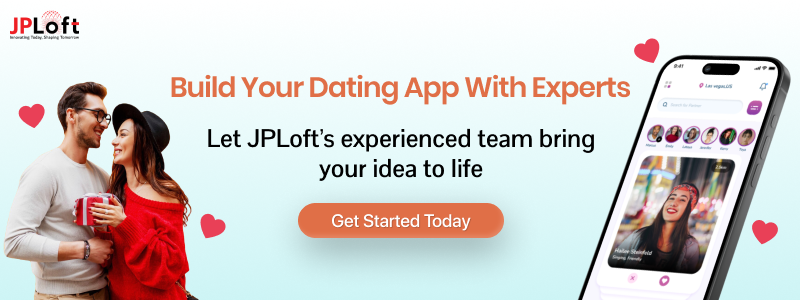
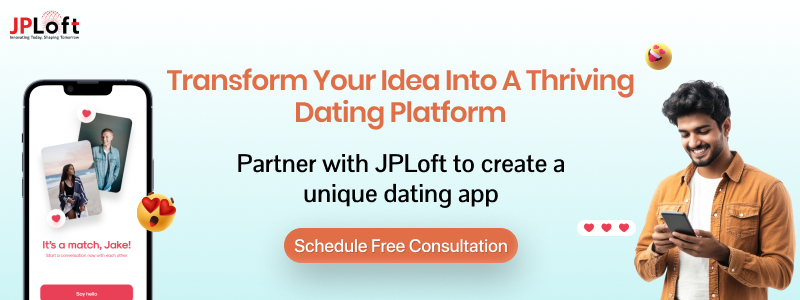
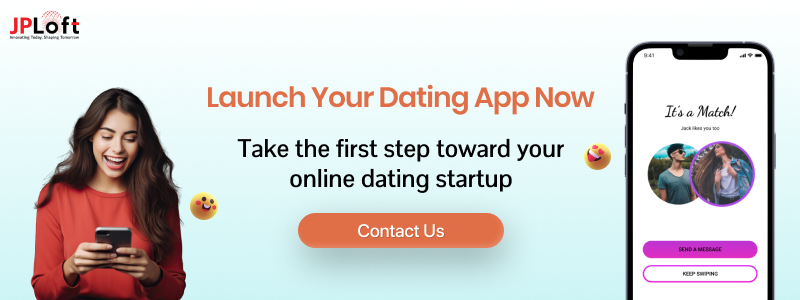


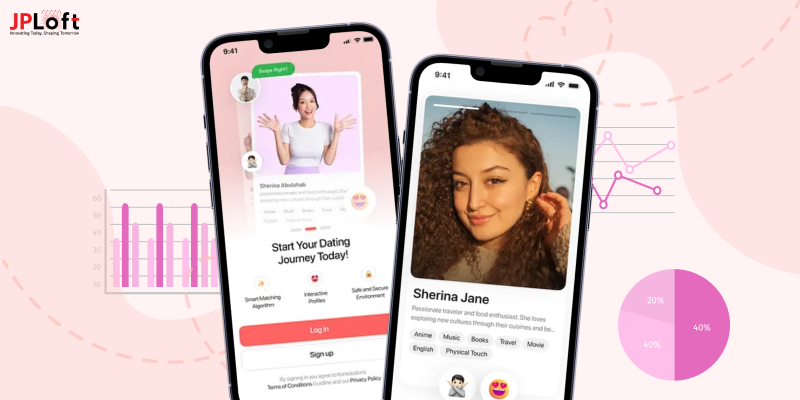
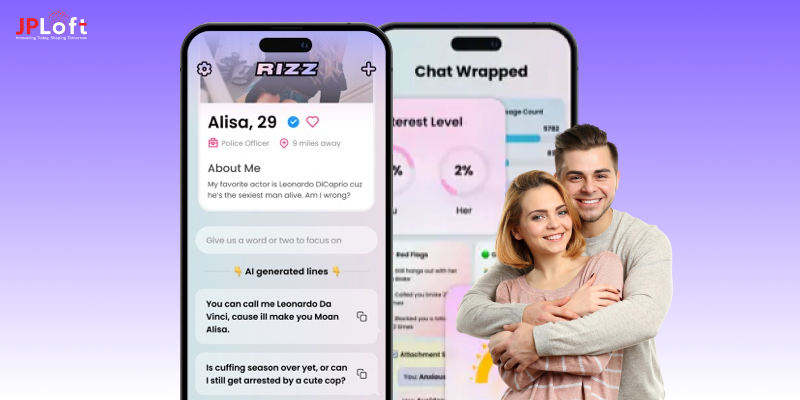



Share this blog